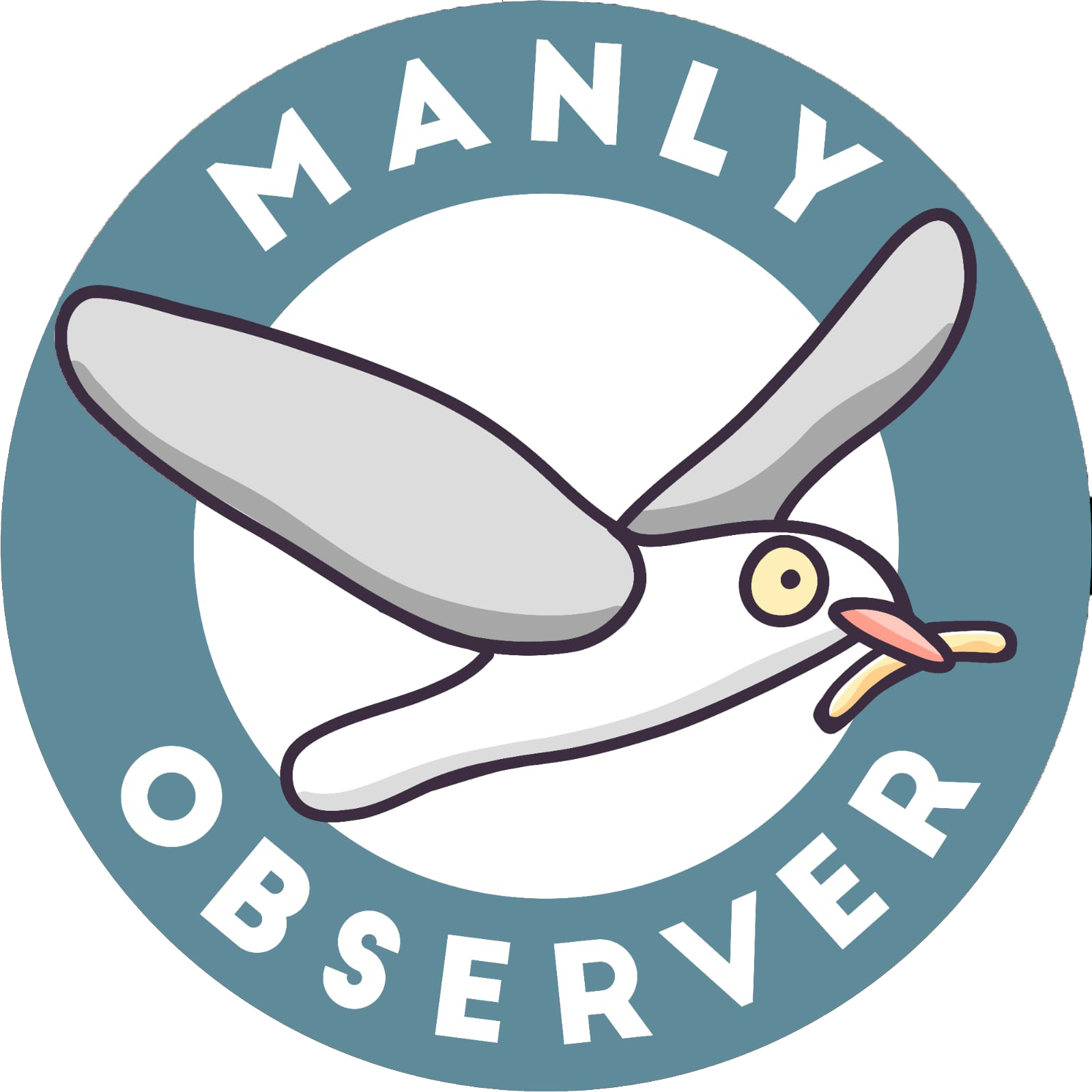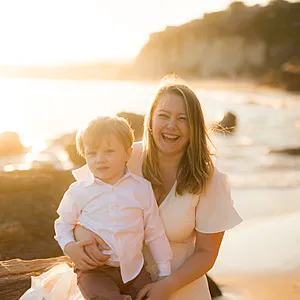A rally to demand an end to ‘commercialisation’ of the Heritage-listed Barrenjoey Lighthouse and the historic cottages on the Barrenjoey Headland attracted 200 participants, despite inclement weather, along with cross-party support from regional political leaders.
On Sunday 22 January, under the banner “Save Barrenjoey Headland from Commercialisation”, an estimated 200 protestors gathered in Governor Phillip Park beside Palm Beach in light rain to express their grievances.
There they heard community leaders and politicians from several different parties outline the case against NSW National Parks and Wildlife Service’s (NPWS) proposals to adapt the Barrenjoey Headland buildings for overnight accommodation plus other modifications to the forested promontory.
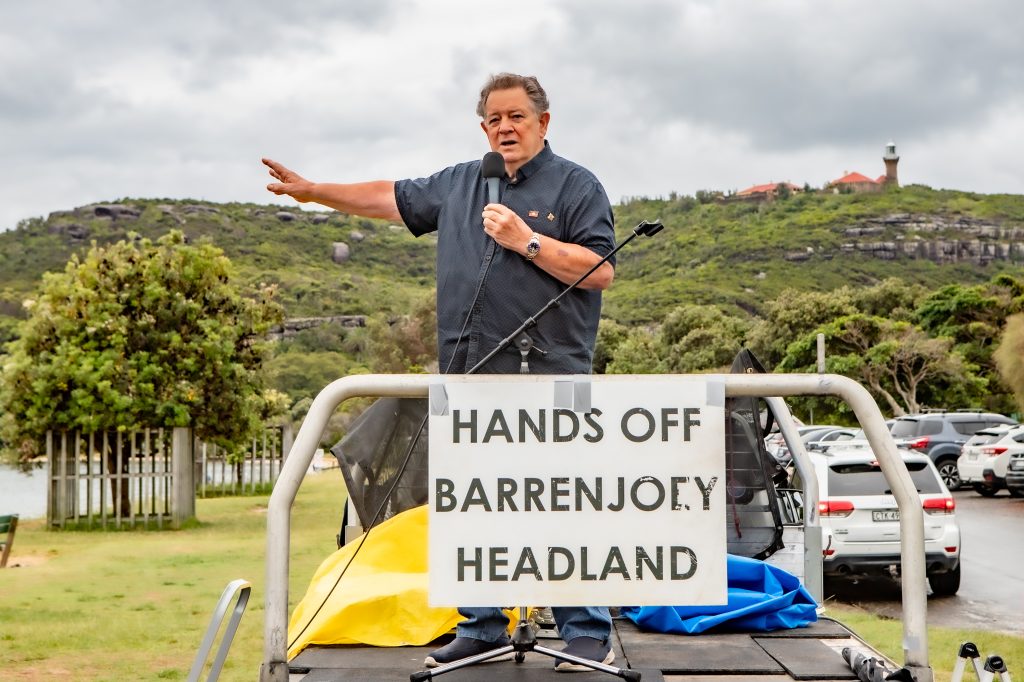
The gathering was entertained by Neil Evers, a descendant of the local Garigal peoples of the Northern Beaches, who gave a formal Welcome to Country greeting.
Speakers at the rally included The Palm Beach and Whale Beach Association (PBWBA) secretary, Robert Mackinnon and PBWBA vice-president Virginia Christensen; Northern Beaches (Pittwater) councillor and prospective NSW candidate for Pittwater, Rory Amon (Liberal); NSW Shadow Minister for Heritage and Environment, Penny Sharpe (Labour); NSW candidate for Pittwater, Hilary Green (Greens) and community spokesperson James Ricketson (a former long-term Pittwater resident who drove up from Goulburn).
12 reasons to say No
Robert MacKinnon, who hosted the rally, explained the principle objections to NPWS proposals. “In September last year, National Parks and Wildlife introduced the new Draft Plan of Management…. Among their proposals was short-stay visitor accommodation at the Assistant Lighthouse Keeper’s Cottage – and there are two up on the headland – and the Boatman’s Cottage on Station Beach, that’s currently used by a National Parks Ranger…
“National Parks use a bureaucratic term called ‘adapting reuse for heritage buildings’. But what does that really mean? It’s a euphemism for modernisation. They have to cater for the needs of paying guests in 2023 – which means new kitchens and bathrooms, new toilets, sewage connection, water connection – there’s no water connected up there at the moment, it’s tank water. Probably reverse-cycle air conditioners…”
Mr MacKinnon listed 12 reasons why the ‘modernisation’ should be opposed. Among these included: the risk of damage to the site’s heritage items and the fine craftwork of the 1881-built lighthouse, designed by government architect James Barnett; the logistics of people ‘trudging’ with all their luggage, food, kids, etc. up the steep path for at least 20 minutes from the carpark to the lighthouse cottages; the difficulties faced by support staff who change sheets and clean the premises in between paying guests; the privacy required by staying guests isolating from the general public that roam around the site during the day; the prohibitive cost of renting overnight that puts it out of the price range of regular wage earners; the risk of party people making noise and making a mess; the difficulty of extracting people who may have been injured or suffered health problems to transport them to hospital; and the disruption to wildlife, particularly nocturnal species, with the increase in human activity 24 hours a day.

Griffin’s assurances
Some of those present also levelled criticisms at the Environment and Heritage Minister James Griffin, with a few expressing dissatisfaction that inquiries sent to him and his department about the future of Barrejoey Headland remained unanswered.
NPWS is a directorate of the New South Wales Department of Planning and Environment, and Mr Griffin, as one of five ministers responsible for the latter, oversees the relevant portfolio concerning heritage conservation.
However, Rory Amon came to Mr Griffin’s defence, stating, “James Griffin has undertaken not to sign any plan of action before the state election.”
He added, “The two cottages referenced in the Draft Plan of Management, the Boatman’s Cottage and the Assistant Lighthouse Keeper’s Cottage, James Griffin has undertaken that under no circumstances will the Boatman’s Cottage be used for accommodation, and that is off the table, as of now, and that’s a good thing.”
“What James Griffin has also undertaken is that the road will not be widened in any way, shape or form. And so the idea that there will be increased capacity to get up there is not going to happen.”
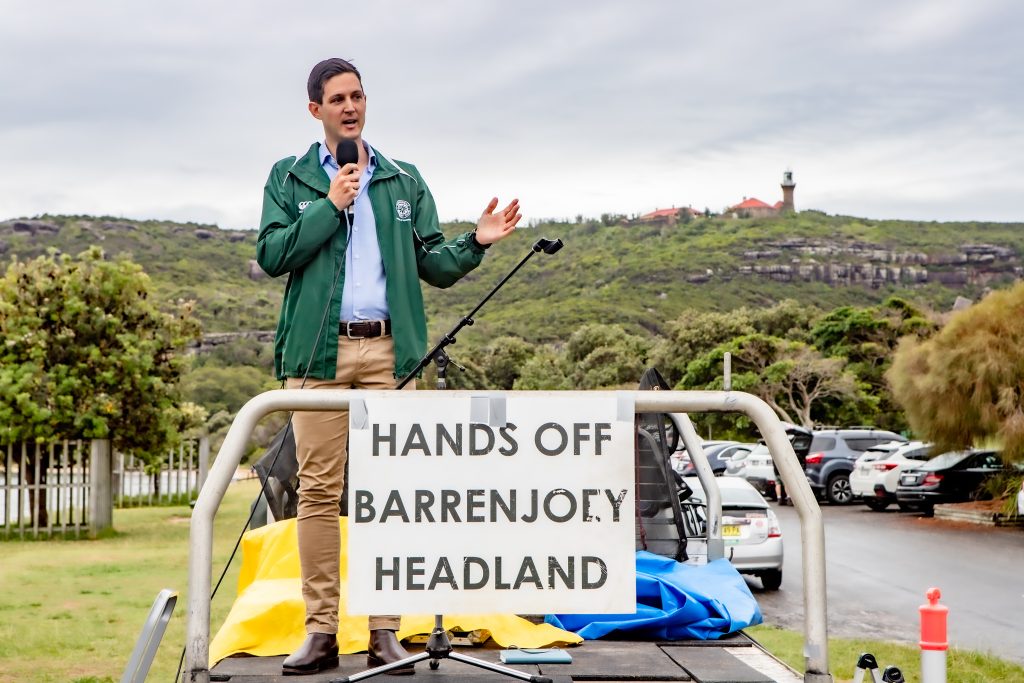
Cr Amon continued, “What I’ll also say is that since the 2013 fires, when the headland was ravaged, this current government has invested $5 million in that facility for bush regeneration and to make the road fit for purpose.
“In 2013 I was here with the Davidson Royal Fire Brigade when we fought the fires that were raging on that headland. And since that time $5 million has been invested, and that includes $3 million on bush regen and the roads, and $2 million dollars for the loos and the toilets, which are to come, which I know is a battle in and of itself…”
Cause and effect?
Shadow Minister for Heritage and Environment, Penny Sharpe, then countered with what she felt was the real issue affecting the drive for commercialisation of heritage sites like Barrenjoey Headland. She explained that when government funding is reduced to services like National Parks and Wildlife, it encourages them to pursue new sources of revenue to make up for the shortfall, which ultimately includes hiring heritage sites out for tourism.
“The current government, over a period of time, has stripped over $120 million out of our national parks system,” she said. “In 2015, I was leaked a memo from the National Parks and Wildlife Service that basically said.. ‘We cannot sustain the cuts that are being made by the government. If we are forced to try and implement all of these cuts, we will have to look for commercialised opportunities everywhere across the state.’
“Fast forward to 2023; all over the state, communities like yours are fighting against this kind of commercialisation – and frankly privatisation – of these precious places…”

Public objections
The principle objections among those opposing modifications and commercialisation of Barrenjoey Headland, appear in the NSW Parks and Wildlife Service’s Recreational Activities Discussion Paper, published 2019 and able to be viewed or downloaded here.
On page four it states: “New overnight experiences may be introduced to the park by adapting existing buildings following environmental and heritage assessment.
“The draft Barrenjoey Head Concept Plan explored the adaptive re-use of the lightkeepers cottages and other buildings for short-stay accommodation. Access to these historically significant buildings is currently limited.”
In the aforementioned draft Barrenjoey Head Concept Plan, released January 2016 and available to download here, it goes into greater detail about how short-term tourist accommodation could be achieved by making architectural changes to the three (one single and a duplex) Lighthouse Caretakers’ Cottages on top of the headland and the Boatman’s Cottage and two Fishers Cottages below. (The latter three are accessible via Fishermans Track from the north end of Station Beach.)
The Concept Plan has an introductory disclaimer that says the report was prepared by Neeson Murcutt Architects Pty Ltd and “The views expressed within are not necessarily the views of the Office of Environment and Heritage (OEH) and may not represent OEH policy.”
Nevertheless, it recommends implementing several modifications for preparing ‘short stay cottages’ for their commercial potential.
These involve installing additions, such as ‘privacy screens’, new footpaths, cladding, sinks, decking and assorted ‘insertions’; however, the refitting is described as ‘sensitive’ to the existing heritage status.

National Parks and Wildlife Service response
NPWS released the following media statement on Monday 23 January:
Adaptive re-use of heritage buildings is common and consistent with best practice for the management and presentation of heritage assets and generally permissible in all parks subject to obtaining required environmental and heritage approvals.
*There are dozens of heritage buildings in national parks that are used for accommodation or other uses.
*These are often booked out 12 months in advance, demonstrating how visitors to national parks appreciate access to these buildings, and rental costs are reasonable and competitive.
*All proceeds are re-invested in park management.
*In relation to the 2 buildings at Barrenjoey:
The 2002 plan of management states that “Adaptive re-use of buildings at Barrenjoey Head will be investigated and implemented subject to environmental assessment processes and approvals under the NSW Heritage Act.”
*The draft revised plan of management released in 2022 does not change the position that adaptive reuse may be considered in future.
*The draft plan was exhibited between 23 September and 22 November to allow the public to comment on the proposals.
*However, even under the plan of management, there are several additional steps that must be undertaken before either of the buildings can be re-used for accommodation. These steps include:
– Feasibility assessment capital funding for assessment, planning approvals and upgrade works required to be consistent with maintaining heritage values;
– Environmental impact assessment through a Review of Environmental Factors;
– Approval under the Heritage Act (given the site is State Heritage Listed any works require a Section 60 Approval from Heritage NSW).
*These steps mean that no re-use will occur before 2025 at the earliest.
*A dedicated community consultation process will be established to support consideration of any proposals and to ensure community views about the potential future use of the buildings are carefully considered.
*NPWS currently has a bigger budget than at any time in its history.
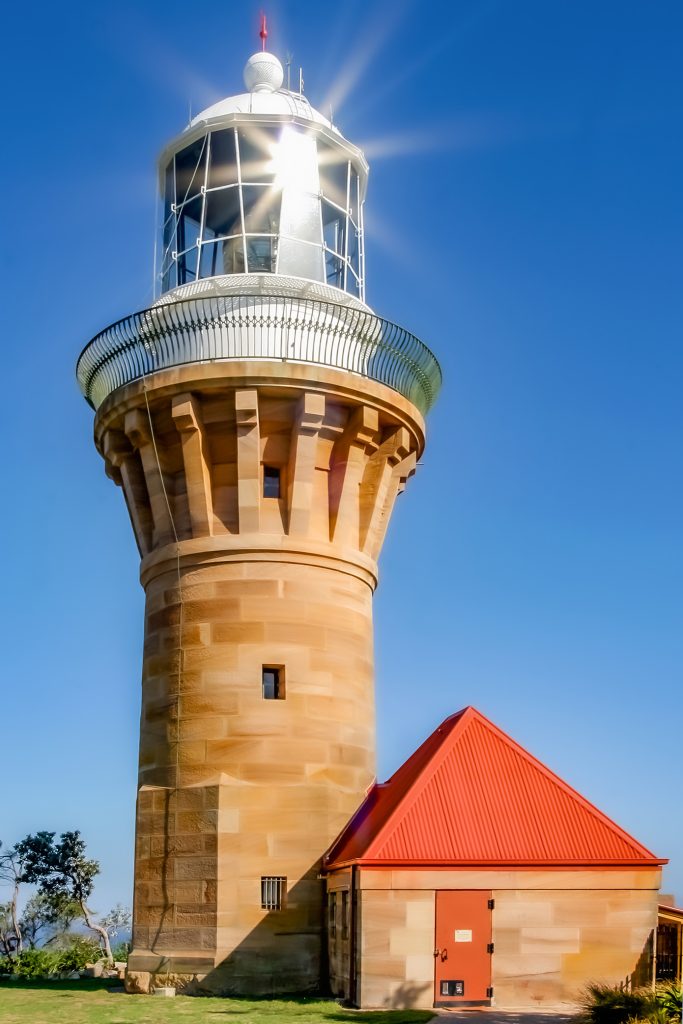
History
The headland was first named “Barrenjuee” by Governor Phillip in 1788, derived from the Dharug Aboriginal name for a small wallaby – which eventually became Barrenjoey. A customs station was established on site in 1843 and eventually a light – a fire basket in a hut built atop the headland – was introduced in 1855 as a navigation aid during dim light and storms for passing mariners.
After a series of deadly shipwrecks, two timber towers were erected in 1878, with lanterns hung inside them, followed by the present day tower, designed by James Barnett and made from sandstone quarried from the headland below.
Construction of the lighthouse was completed in August 1881, when the original oil-burning lamp was first ignited. At an elevation of 113 metres, the light was visible to ships up to 19 nautical miles away.
In 1932 the lighthouse was automated, and lighthouse keepers stood down, whereupon the cottages soon fell into disrepair or were vandalised and were not repaired and reoccupied until the 1950s. Then, in 1972, the lamp was converted to electricity, with a new bulb capable of 75,000 candlepower.
Barrenjoey Lighthouse
https://www.nationalparks.nsw.gov.au/things-to-do/historic-buildings-places/barrenjoey-lighthouse
Palm Beach and Whale Beach Association
https://pbwba.org.au/barrenjoey-lighthouse-commercialisation/
Draft Barrenjoey Head Concept Plan

